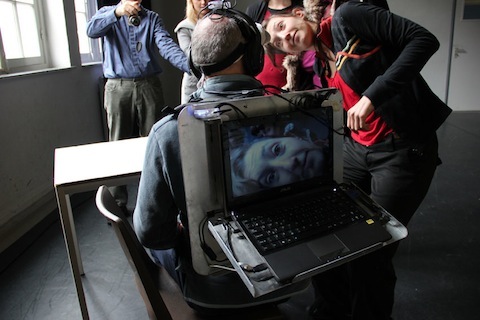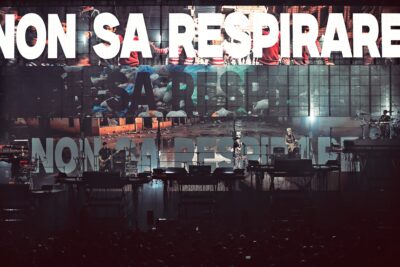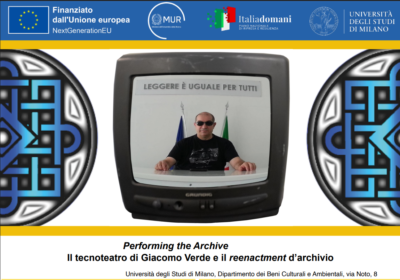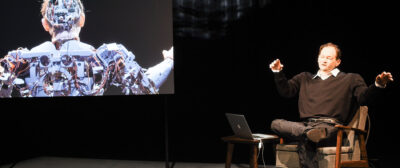Presence: Presence has been a key concept for understanding the effectiveness of virtual reality. It’s a psychological phenomenon that has been defined as the participant’s sense of ‘being there’ in a virtual environment (VE). It is a mental state in which a user feels physically present within the computer-mediated environment. It has been widely argued that the interaction with this virtual world on various levels is an important source of presence, stimulating both the bodily and cognitive activity of the user. [Wynants Nele, Vanhoutte Kurt, Bekaert Philippe.- Being inside the image: heightening the sense of presence in a video captured environment through artistic means.- In: Presence 2008: proceedings of the 11th International Workshop on Presence in Padova / Spagnolli, Anna [edit.]; e.a., Padova, Libraria Universitaria Padova, 2008, p. 157-162]
Hybrid/Transitional Space: We would no longer describe the embodied environment in terms of virtual as opposed to real, but as a hybrid space in between/springing from different levels of perceived reality. By intermingling these different sensorial stimuli [in CREW’s performances ](live, prerecorded and mediated) the senses are played off against each other, in a perpetual negotiation about the experienced environment. We would argue that presence, or the feeling of being there, is enhanced in particular during this transitional moments, where one has to redefine his world based on the sensorial information. It is in this shifting moment between the embodied and the perceived world, on the fracture between what we see and what we feel that the spectator has the strongest feeling of being there in an immersive experience. In this hybrid experience, the perception of the own body is pushed to the extreme, causing a most confusing corporal awareness.
[Vanhoutte Kurt, Wynants Nele.- Pending presence: negotiating the space inbetween.- In: Space cowboys: how art creates, networks and visualises hybrid spaces / Klaveren, van, Rosanne [edit.]; et al. [edit.], Genk, Media and Design Academy, 2009, p. 58-72]
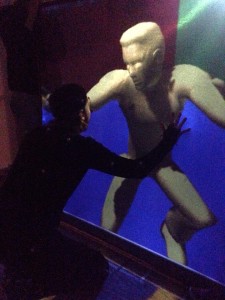
“Turn on, Tune in, Drop out”
Omnidirectional Video: omni-directional video (ODV) [is] a new immersive medium that allows the spectator a surround video display by means of a head mounted display (HMD). Equipped with an orientation tracker this HMD shows a sub-image of the panoramic video that corresponds with the spectator’s view direction and desired field of view. (…) ODV places the viewer physically in a video-captured image, generating an environment more true to live. Moreover, the filmed image becomes a space in which the viewercan walk around. The virtual space coincides with the embodied own space, integrating thus the story world into the physically perceived world of the spectator.
[Vanhoutte Kurt, Wynants Nele.- Pending presence: negotiating the space inbetween.- In: Space cowboys: how art creates, networks and visualises hybrid spaces / Klaveren, van, Rosanne [edit.]; et al. [edit.], Genk, Media and Design Academy, 2009, p. 58-72]
Rubber Hand Illusion: In this scientific experiment the sight of brushing of a rubber hand at the same time as brushing of the person’s own hidden hand has proved to be sufficient to produce a feeling of ownership of the fake hand. Under such conditions of multi-sensory conflict, vision typically dominates over proprioception and touch. In other words, the friction between simultaneous sensorial stimuli is cognitive unified in a coherent experience where the dominance of vision causes the feeling that the virtual hand is owned by the person involved.
[Wynants Nele, Vanhoutte Kurt, Bekaert Philippe.- Being inside the image: heightening the sense of presence in a video captured environment through artistic means.– In: Presence 2008: proceedings of the 11th International Workshop on Presence in Padova / Spagnolli, Anna [edit.]; Padova, Libraria Universitaria Padova, 2008, p. 157-162]
Headswap: Headswap is the technological dispositive of W (Double U), a collaborative interactive performance. “In this performance, immersive technology is used for the live exchange of vision. Two spectators in different geographic locations are equipped with a head mounted omni-directioSnal camera and display. By means of this immersive equipment their fields of vision are swapped, which enables the participants to perceive the world through another person’s point of view. Moreover, they can look and move around in each other’s field of vision, and have to perform by sustaining and guiding each other via microphone and headset. They embody, as it were, the visual field of the other, somewhere else.
[Forthcoming publication : Wynants Nele, Vanhoutte Kurt, “Performing phenomenology: Negotiating presence in intermedial theatre.” In : A Special Issue of Foundations of Science: “Opening up the in-between: interdisciplinary reflections on science, technology and social change.” Springer, 2010 (in press).]

